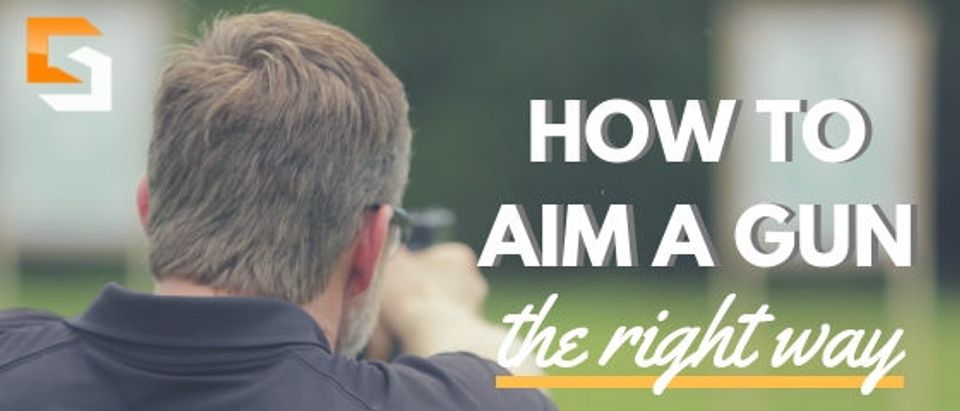By Chris Sajnog, Author Navy SEAL Shooting
Aiming your gun needs to be done a certain way if you like hitting your target. I think it’s fair to assume you like hitting your target, right? Before you can really understand how to aim a gun, I want to make sure we’re all on the same page about some technical terms.
First up is sight alignment. Sight alignment involves your front and rear sights. Most pistols have an open sighting system, meaning your rear sight is “U” shaped and your front sight is “I” shaped. To align the sights, you want the I in the center of the U and the tops of both sights even.
What I’ve just briefly described is a two plane sighting system (think physics, not airplanes). With this system, there are two types of errors you can encounter: angular shift errors and parallel shift errors. An angular shift error occurs when the front sight post (the I) is too close to either bar of the rear, U-shaped, sight post. Simply put, the I isn’t centered in the U and you’re going to miss your target completely.

With a parallel shift error, your sights are perfectly aligned—they are the definition of picture perfect sight alignment—but your sight picture is off! So instead of aiming directly at the center of your target, your sight picture is slightly higher or lower (or left or right) of where you want to hit. Sight picture is everything you can see beyond the end of your weapon, including your target.
It’s really important that you remember these two errors. They are foundational and their correction can solve so many shooting problems.
While we’re talking about the sights, I want to quickly touch on sight radius and why rifles and carbines are more accurate than pistols. It’s pretty simple—your sight radius is the distance between your sights. The greater the distance, the more accurate your shot will be. Another important consideration that most people ignore is the relative size of your front post to your rear sight. When properly aligned, there should be a little bit of light on each side of the front post.
Now, we need to talk about focus and awareness.
When I tell people to focus on the front sight and NOT the target, they look at me a little funny. Then I explain it, and everything falls into place for them. The key here is that you can only focus on one thing at a time but you can be aware of millions of things at one time. Take a second and try this: focus on the bold word below and while you’re focusing on it, mentally inventory everything else around you that you are aware of.
Focus
You may have been surprised by just how many things you can be aware of at one time. Or maybe not, maybe this was difficult for you. For those of you who had difficulty, meditation can be used to help hone your awareness skills.
Next up is where to align the front sight post on your target. There are two schools of thought here: center mass hold or a six o’clock hold. Can you guess which one I prefer? (Hint: The name of my company is Center Mass Group.) A center mass hold is when the top of your perfectly aligned sights are even with the very center of your target. A six o’clock hold is when the top of your sights align with the very bottom of your target.
Now, I can’t say the six o’clock hold won’t work, but I can say it’s not nearly as effective as a center mass hold. First, given the way our eyes work, we can find the exact center of any target regardless of shape or size, but when we are trying to find the bottom of the target, our eyes blur out the target in an effort to get the front sight post aligned with the bottom. Because the target is now blurry, we cannot find the exact bottom point at which to aim.
Secondly, the six o’clock hold assumes a circular target. Well, we aren’t always going to be shooting at circles are we? It also introduces too many variables such as how big your target is and how far away from the target you are. In a life or death situation you DO NOT want to be guessing about these variables. Aim for the center and you’ll hit the center.
Maybe after reading this, you’re still not sure that what I’m offering is a better way to shoot. But the next time you’re at the range or practicing with a laser system, give my way a try and see what happens. I think you’ll find that making some small changes will result in big improvements.
Retired Navy SEAL Chris Sajnog, a Master Training Specialist in the Navy, was hand-selected to write the US Navy SEAL Sniper Manual. He used this experience, plus four years of studying neuroscience and elite performance, to develop the New Rules of Marksmanship — a fundamental shift in learning how to shoot. He’s the author of two bestselling books, How to Shoot Like a Navy SEAL and Navy SEAL Shooting, and the owner of Center Mass Group, LLC a 100% Service-Disabled Veteran-Owned Small Business in San Diego, CA. Chief Sajnog, now offers his unique training online at https://chrissajnog.com.


